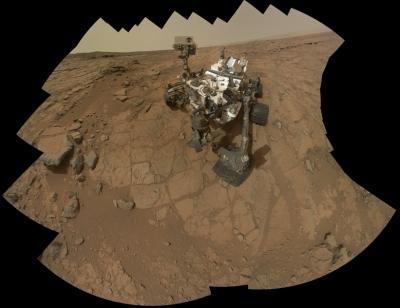Sat, Oct 19, 2013
Presence Of Two Forms Of Argon Detected By Curiosity Lead To Determination
Examination of the Martian atmosphere by NASA's Curiosity Mars rover confirms that some meteorites that have dropped to Earth really are from the Red Planet. A key new measurement of the inert gas argon in Mars' atmosphere by Curiosity's laboratory provides the most definitive evidence yet of the origin of Mars meteorites while at the same time providing a way to rule out Martian origin of other meteorites.

The new measurement is a high-precision count of two forms of argon -- argon-36 and argon-38 -- accomplished by the Sample Analysis at Mars (SAM) instrument inside the rover. These lighter and heavier forms, or isotopes, of argon exist naturally throughout the solar system. On Mars the ratio of light to heavy argon is skewed because much of that planet's original atmosphere was lost to space. The lighter form of argon was taken away more readily because it rises to the top of the atmosphere more easily and requires less energy to escape. That left the Martian atmosphere relatively enriched in the heavier isotope, argon-38.
Years of past analyses by Earth-bound scientists of gas bubbles trapped inside Martian meteorites had already narrowed the Martian argon ratio to between 3.6 and 4.5 (that is 3.6 to 4.5 atoms of argon-36 to every one of argon-38). Measurements by NASA's Viking landers in the 1970s put the Martian atmospheric ratio in the range of four to seven. The new SAM direct measurement on Mars now pins down the correct argon ratio at 4.2. "We really nailed it," said Sushil Atreya of the University of Michigan, Ann Arbor, lead author of an Oct. 16 paper reporting the finding in Geophysical Research Letters. "This direct reading from Mars settles the case with all Martian meteorites."
One reason scientists have been so interested in the argon ratio in Martian meteorites is that it was -- before Curiosity -- the best measure of how much atmosphere Mars has lost since the planet's wetter, warmer days billions of years ago. Figuring out the planet's atmospheric loss would enable scientists to better understand how Mars transformed from a once water-rich planet, more like our own, into today's drier, colder and less-hospitable world. Had Mars held onto all of its atmosphere and its original argon, its ratio of the gas would be the same as that of the sun and Jupiter. Those bodies have so much gravity that isotopes can't preferentially escape, so their argon ratio -- which is 5.5 -- represents that of the primordial solar system.
While argon makes up only a tiny fraction of the gas lost to space from Mars, it is special because it's a noble gas. That means the gas is inert, not reacting with other elements or compounds, and therefore a more straightforward tracer of the history of the Martian atmosphere. "Other isotopes measured by SAM on Curiosity also support the loss of atmosphere, but none so directly as argon," said Atreya. "Argon is the clearest signature of atmospheric loss because it's chemically inert and does not interact or exchange with the Martian surface or the interior. This was a key measurement that we wanted to carry out on SAM."
The Curiosity measurements do not directly measure the current rate of atmospheric escape, but NASA's next mission to Mars, the Mars Atmosphere and Volatile Evolution Mission (MAVEN), is designed to do so. That mission is being prepared at NASA's Kennedy Space Center in Florida for a launch-opportunity period that begins on Nov. 18.
(Image provided by NASA)
More News
With Testing Soon Complete, Launch Preparations Begin in Earnest Sierra Space's Dream Chaser has been put through the wringer at NASA's Glenn Armstrong Test Facility in Ohio, but w>[...]
Takeoff Roll The process whereby an aircraft is aligned with the runway centerline and the aircraft is moving with the intent to take off. For helicopters, this pertains to the act>[...]
“We’re proud of the hard work that went into receiving this validation, and it will be a welcome relief to our customers in the European Union. We couldn’t be mor>[...]
"Aircraft Spruce is pleased to announce the acquisition of the parts distribution operations of Wag-Aero. Wag-Aero was founded in the 1960’s by Dick and Bobbie Wagner in the >[...]
IDENT Feature The special feature in the Air Traffic Control Radar Beacon System (ATCRBS) equipment. It is used to immediately distinguish one displayed beacon target from other be>[...]
 Sierra Space Repositions Dream Chaser for First Mission
Sierra Space Repositions Dream Chaser for First Mission ANN's Daily Aero-Term (05.10.24): Takeoff Roll
ANN's Daily Aero-Term (05.10.24): Takeoff Roll Aero-News: Quote of the Day (05.10.24)
Aero-News: Quote of the Day (05.10.24) Aero-News: Quote of the Day (05.11.24)
Aero-News: Quote of the Day (05.11.24) ANN's Daily Aero-Term (05.11.24): IDENT Feature
ANN's Daily Aero-Term (05.11.24): IDENT Feature



